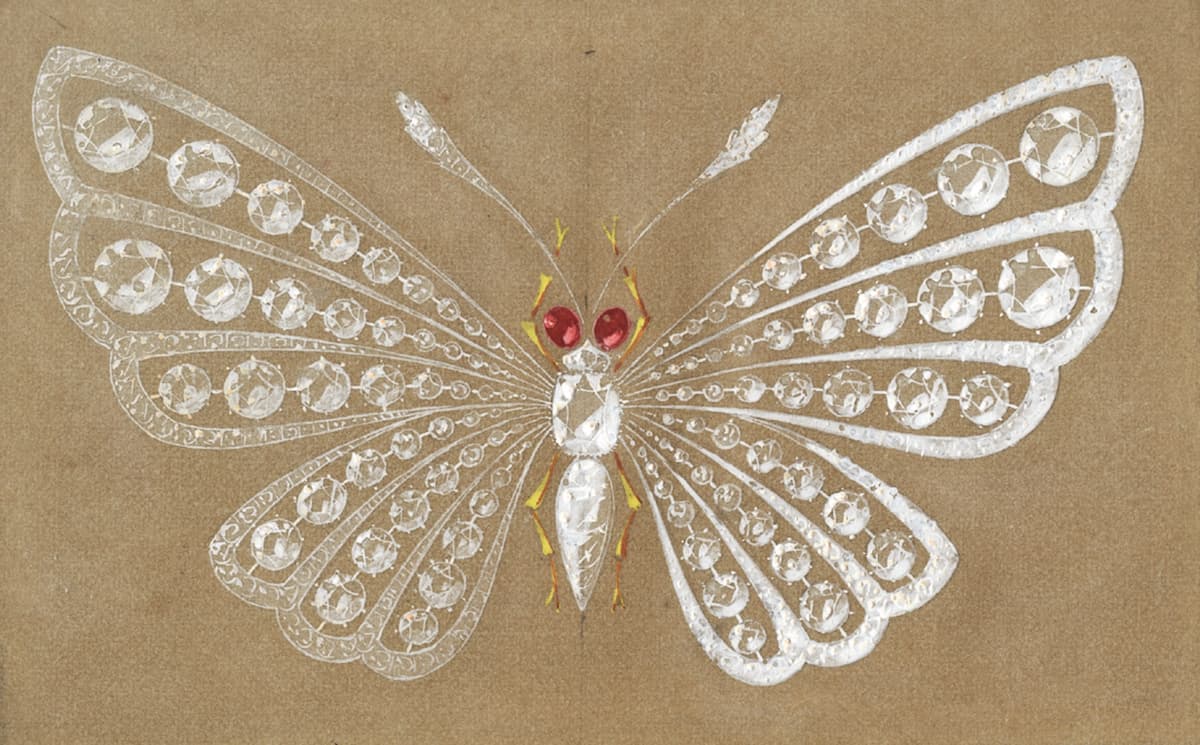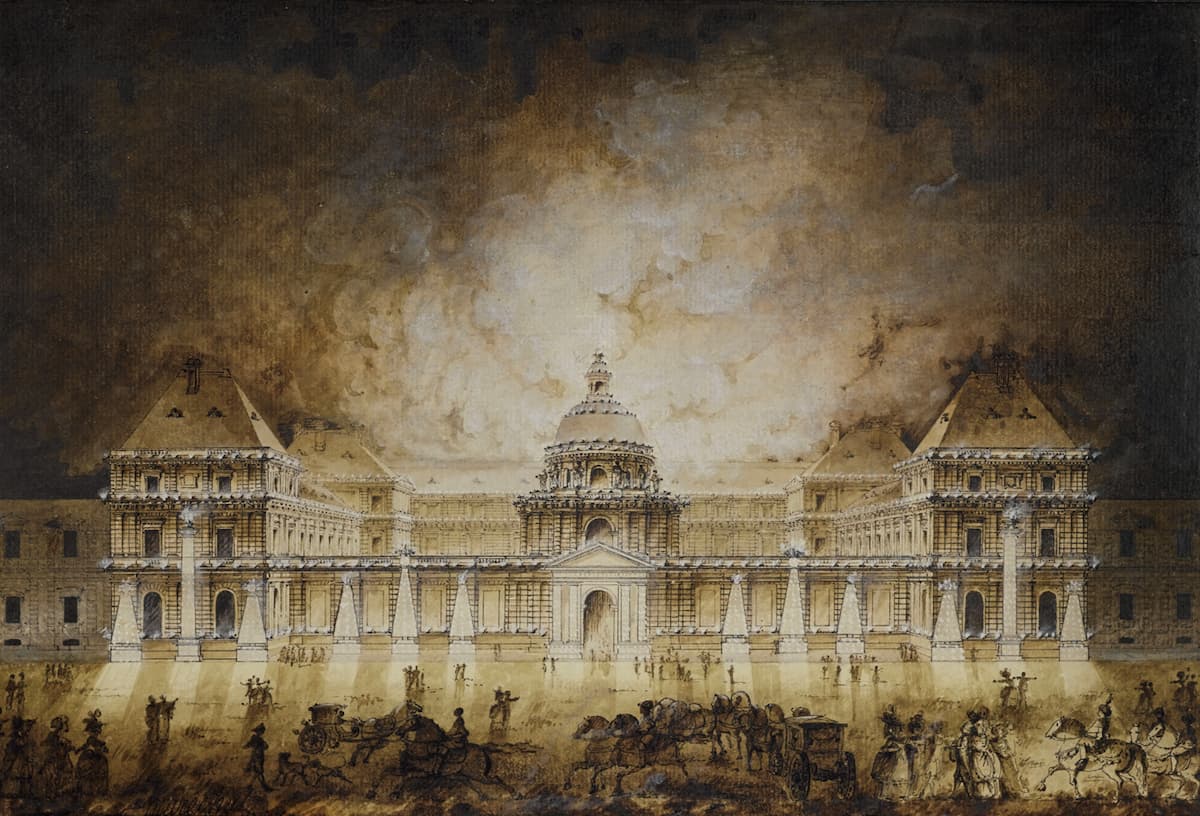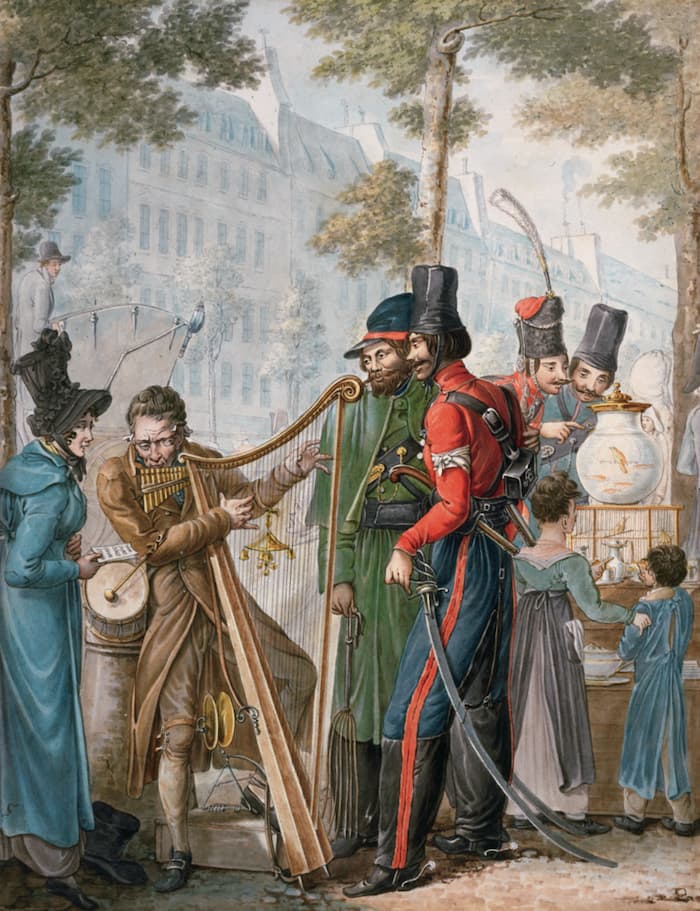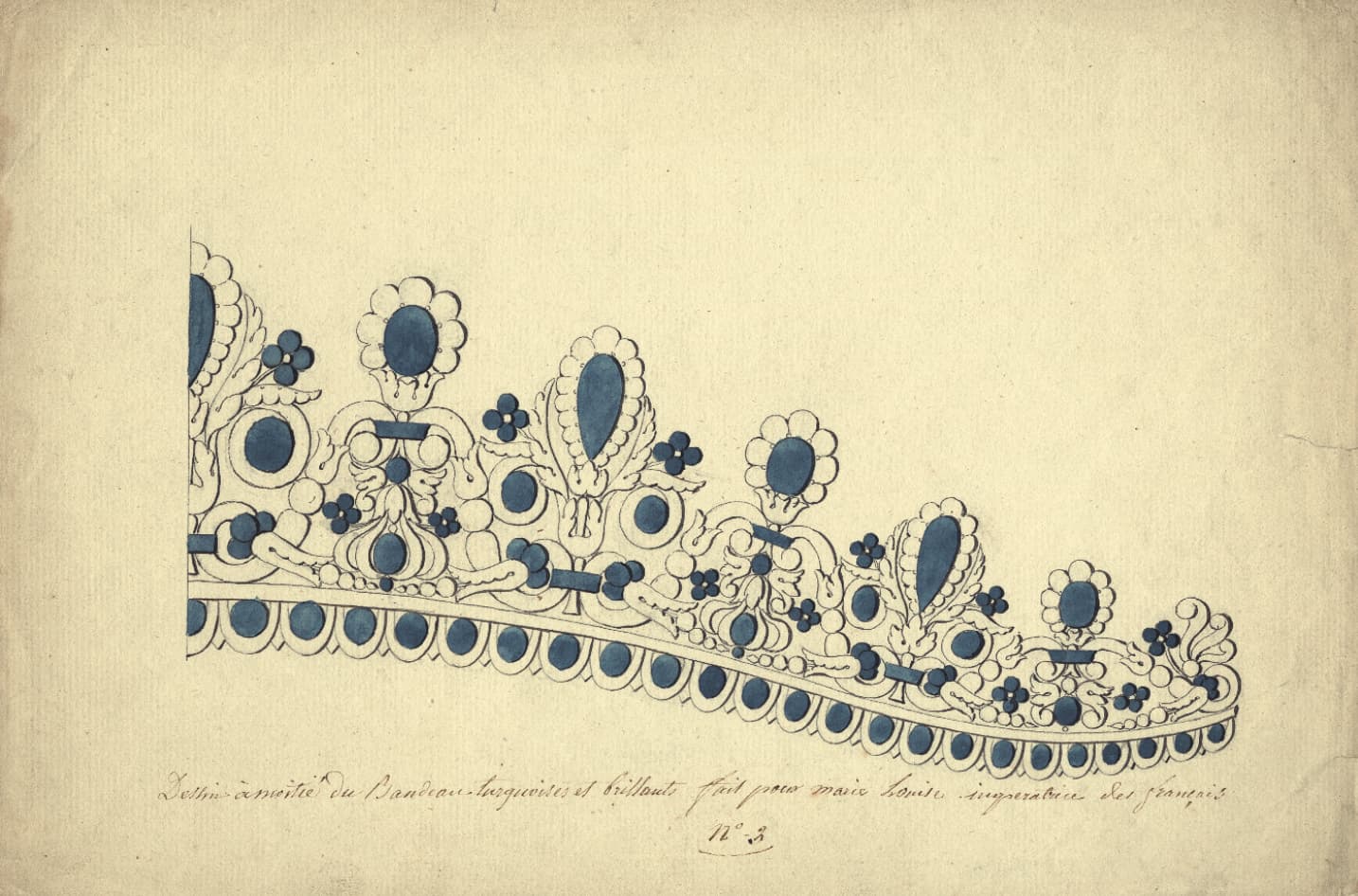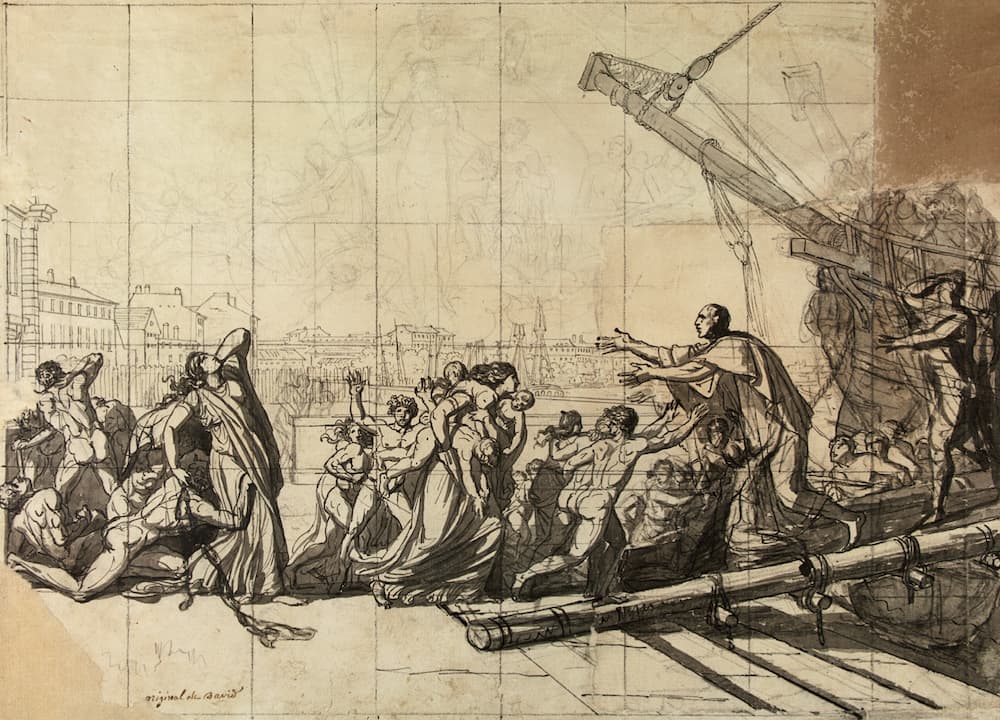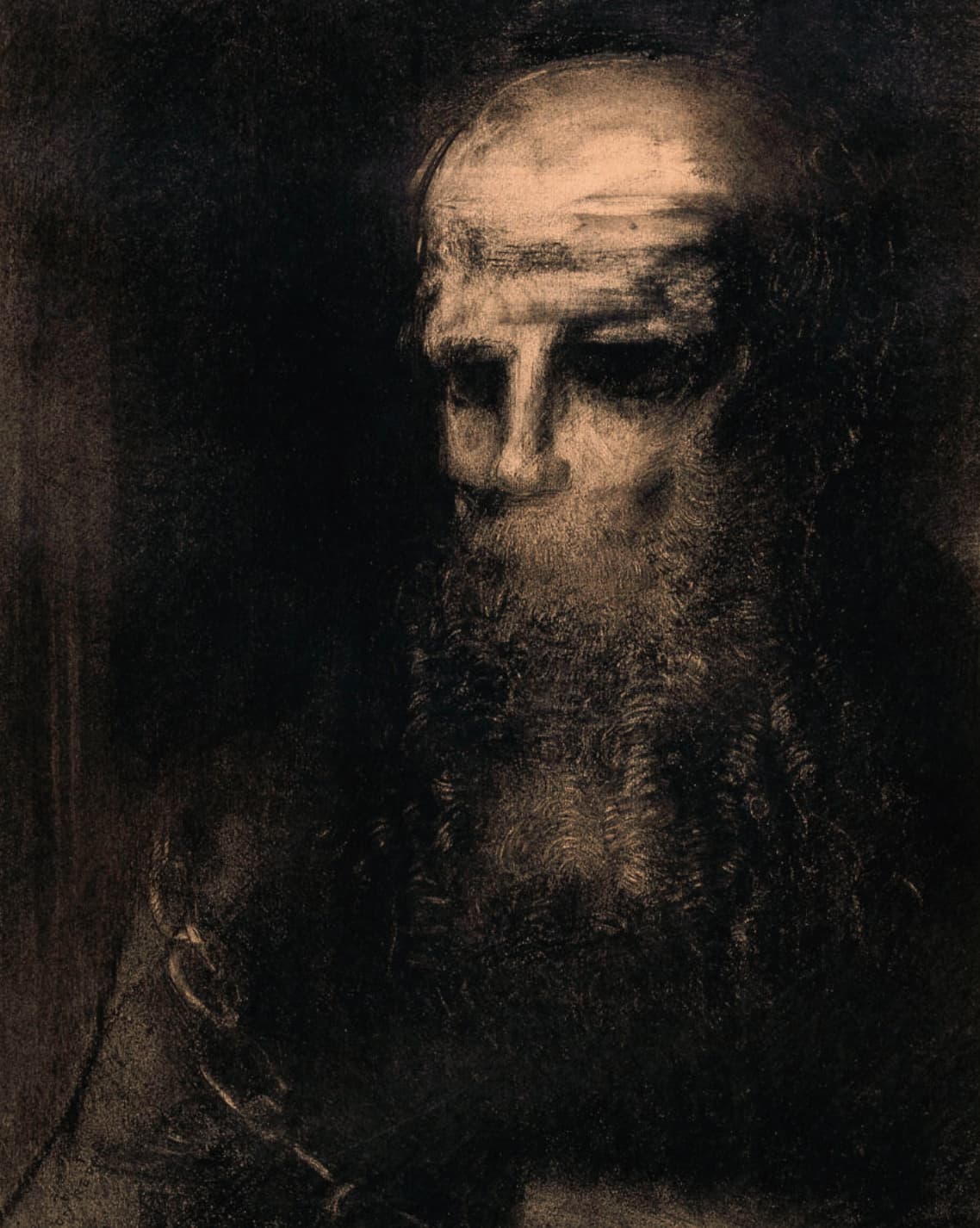DUBUFFET FOUNDATION
Jean Dubuffet on paper
The Fondation Dubuffet, which celebrated its 50th anniversary in 2024, has been chosen to be the guest of honor at Salon du Dessin.
Created by the artist himself, the foundation was recognized of public utility by decree in 1974. The present exhibition is one of the first events organized for this anniversary. It follows in the footsteps of the prestigious institutions invited until now, which chose to exhibit the finest "sheets" from their collections. The term "sheet" has a conventional resonance that Jean Dubuffet, who never ceased to oppose academic values, would undoubtedly have rejected. The foundation's choice was based on the variety of techniques and their inventive use by the artist, but whose common medium is paper.
With a collection of more than 1,300 works on paper, donated by the artist during his lifetime or acquired more recently, the foundation has selected 55 works created between 1935 and 1985.
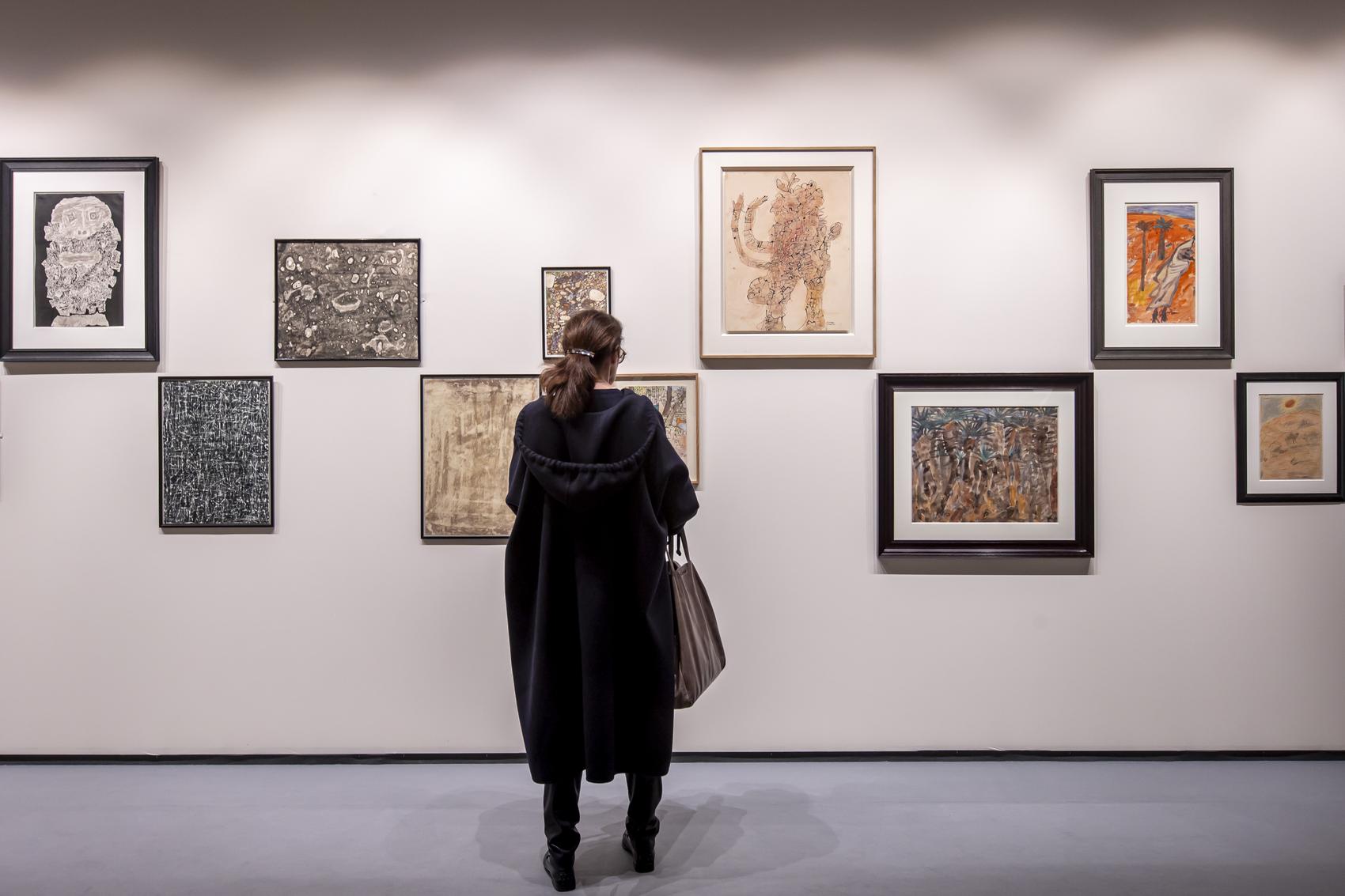
TAVOLOZZA FOUNDATION
French drawings from the 18th to the early 20th century in the Katrin Bellinger Collection
Katrin Bellinger began collecting in 1985 in parallel to her career as a dealer in Old Master drawings. Fascinated with the artistic process and the mystique surrounding it, she chose to focus on one theme: the artist at work. Since then the collection has expanded considerably and now includes over 1800 examples in a range of media – drawings, paintings, prints, photographs and sculpture – from the Renaissance to the present day.
At the 2024 Salon du Dessin, the Katrin Bellinger Collection drew from one of its strengths and showed a selection of French drawings dating from the eighteenth to early twentieth century.

2023
MUSÉE DE L'ARMÉE
The collection of drawings at the Musée de l'Armée
Renowned for its weapons, ancient armour and uniforms, the Musée de l'Armée houses a little-known collection of drawings, estimated today at 10,000 works.
The selection on display in this exhibition, ranging from the 16th to the 21st century, has invited visitors to discover the diversity of this collection and allows them to observe the vast thematic field that the military world can offer, without forgetting the site in which this collection is housed today, the Hôtel des Invalides.

Mai Van Nam
La Partisane, 1966.
Inv. 2019.64.3,
H. 38,7 ; L. 54,3 cm
FONDATION CUSTODIA
FRITS LUGT COLLECTION
A tribute to Ger Luijten
The Salon du Dessin wanted to join the many tributes paid to Ger Luijten, director of the Fondation Custodia, who died suddenly on December 19, 2022.
A selection of twelve works chosen from among his acquisitions at the Salon, as well as from other participants in the Semaine du Dessin during his directorship, was presented on this occasion.

© Yannick Pyanee
2022
GRAND SIÈCLE MUSEUM
Pierre Rosenberg drawings donation
Georges Siffredi, President of the Hauts-de-Seine Department, inaugurated the prefiguration pavilion of the Grand Siècle museum, installed in the Petit Château de Sceaux, within the Departmental Domain of Sceaux. Ambitious cultural project of the Department, the Grand Siècle museum is due to open its doors in the former Sully barracks in Saint-Cloud at the end of 2025.
The prefiguration pavilion is located in the Departmental Domain of Sceaux alongside the museum dedicated to the art of living and French taste from Louis XIV to Napoleon III.
The Petit Château will host the prefiguration mission of the Grand Siècle museum for the next four years. This was created with a triple aim: to design the scientific and cultural project of the future establishment, to develop its collections, and to finalize the architectural and scenographic project.

Michel DORIGNY (1616-1665)
Homme barbu ailé
22,5 x 20 cm
© Suzanne Nagy
MUSÉE DES ARTS DÉCORATIFS
Achille Duchêne and the gardens show
Drawings from the Musée des Arts Décoratifs
In 1913, the Musée des Arts Décoratifs devoted a retrospective exhibition to The art of gardens in France from the 16th to the 18th century, to mark the third centenary of the birth of André Le Nôtre.
Numerous items exhibited were loaned by the landscape architect Achille Duchêne, sometimes called the “reincarnation” of Louis XIV’s gardener. In the Annuaire du Luxe à Paris published by Paul Poiret and Edy Legrand in 1928, he himself bragged that he had “renovated the art of gardening in France” and illustrated his words with a drawing: surrounded by figures in costume, seen from the back, a gardener-orchestra conductor reveals a jardin à la française (garden in the French manner) displayed before him like a scene from a play. In an amusing interplay of words and mirror images, a parterre of 17th century men admires a 20th century embroidery-patterned parterre, fully approving of it.

Michel DORIGNY (1616-1665)
Homme barbu ailé
22,5 x 20 cm
© Suzanne Nagy
2021 & 2020
MUSÉES DE MARSEILLE
Three centuries of drawings from the musées de Marseille
Works from
The musée des Beaux-Arts de Marseille, the musée Grobet-Labadié and the musée des Arts Décoratifs, de la Faïence et de la Mode
Curators
General curator : Xavier Rey, directeur des musées de Marseille
Scientific curators : Luc Georget, curator of the musée des Beaux-Arts de Marseille and Gérard Fabre, assistant at the musée des Beaux-Arts de Marseille

Anonyme, XVIe siècle
Choux
Watercolor on parchment (Marseille, musée Grobet-Labadié)
© Ville de Marseille, Dist. RMN-Grand Palais / image des musées de la ville de Marseille
The presence of the Salon du dessin’s guest this year, the Musée des Beaux-Arts de Marseille, offers an opportunity to show a selection of drawings from its graphic arts department as well as from two other Marseille museums with old master drawing collections, the Musée Grobet-Labadié and the Musée des Arts Décoratifs, de la Faïence et de la Mode.
In line with the theme of this year’s fair, the art of gardens and botany, works depicting nature in one form or another were selected from the three museums’ collections. Forty drawings dating from the 15th to the 19th century – including works by Pierre Puget, Jean-Baptiste Huet, Jean-Honoré Fragonard, Hubert Robert, Jean-Antoine Constantin and Camille Corot – will offer a sampling of the treasures to be found in Marseille’s museums.
Anonyme, XVIIe siècle
Arbres
Pen, pencil, ink and brown ink wash on paper (Marseille, musée des Beaux-Arts)
© Ville de Marseille, Dist. RMN-Grand Palais / image des musées de la ville de Marseille
Since 1869, the Musée des Beaux-Arts de Marseille has been housed in the left wing of the Palais Longchamp in superb rooms specially designed for its collections by architect Henry Espérandieu.
The museum’s beginnings 60 years earlier were much more modest, however. The collection was presented to the public for the first time in 1804 in the chapel (built in 1751) of the former bernardine convent. It was one of 15 museums created in major French cities by the Consulate’s Chaptal Decree of XIV Fructidor, Year IX. When it opened, the marseillais discovered works obtained by the revolutionaries’ confiscations of the property of locals, religious establishments and emigrants, as well as masterpieces taken by the young Republic from both French territory and lands conquered by its victorious armies in Italy, Flanders and Germany. These works, through which visitors could trace the history of the French, Italian and northern schools, had been sent by the state two years earlier to enrich the museums it had just created in the provinces.
While there were no drawings in the first museum, a graphic arts department was established during the 19th century. The largest part consisted of Italian and especially French works dating from the 16th to the 19th century. Like the painting and sculpture collections, the graphic arts collection stands out for the number of works testifying to the richness and dynamism of artistic creation of the Provence.
Jean-Honoré Fragonard
Les Cascatelles de Tivoli
Red chalk
(Marseille, musée des Arts décoratifs, de la Faïence et de la Mode)
© Ville de Marseille, Dist. RMN-Grand Palais / Claude Almodovar
A museum always ends up reflecting its artistic environment. During the museum’s two centuries of existence – thanks to the usual sources of a public collection’s enrichment: acquisitions, donations and legacies – its collections came to reflect the development of the arts in the Provence and the tastes of the local elite: the Borélys in the 18th century and Emile Ricard, Charles Magne and Hippolyte Mireur in the following century.
Two of Marseille’s museums were born of the generosity of collectors at the start of the 20th century. They are the Musée Grobet-Labadié, located in the mansion where art lover Marie Grobet lived, and the Musée Cantini, which, before it became a well-known Marseille museum of modern art, housed the remarkable old master collection of the sculptor and art patron Jules Cantini.
These two art lovers had a strong interest in the graphic arts, and many of the works in their collections have recently been reattributed. The 20th century was a good time for drawing in Marseille: in 1964, Maurice Feuillet gifted the city of Marseille a remarkable set of works on paper, most of them by great masters of the French 18th century.
2019
CHAUMET
Nature drawing / design
Chaumet 12, place Vendôme 7001 Paris
165, boulevard Saint-Germain 75006 Paris
Joseph Chaumet (1852-1926), atelier de dessin
Documentary study of foliage, clematis, buttercup, wild strawberry, hawthorn, ivy and bindweed, circa 1885 Clematis sp., Ranunculus sp., Fragaria vesca, Crataegus monogyna, Hedera helix et Calystegia sepium
Crayon graphite, lavis et rehauts de gouache sur papier translucide, 255 x 181 mm. Collection Chaumet Paris, inv. BDC-012-1.

The house of Chaumet has always celebrated vibrant, fertile nature in its jewelry designs, with stalks of wheat bending in the wind, lilies, roses, reeds, butterflies and so on.
Joseph Chaumet (1852-1926), atelier de dessin
Gold, silver, diamond and ruby butterfly brooch project, circa 1890
Washes and heightened with gouache and golden pigments on translucent paper, 72 x 112 mm. Chaumet Collection, Paris, inv. B-40-771.
In the exhibition Chaumet: Nature Drawing / Design, inspirational and technical drawings and gouaches of the finished jewelry trace the artistic history of the house, the creator of a real and symbolic universe.
An experienced observer and virtuoso jeweler, Chaumet has found a way of representing flora and fauna that transcends technique to let the character and grace of precious stones shine through.
The exhibition offers a rare behind-the-scenes peek at a world where line and gesture unite to brilliantly enchant the eye.
Joseph Chaumet (1852-1926), atelier de dessin
Front "daisy" bodice project, gold, silver, diamond, circa 1890
Leucanthemum vulgare
Graphite pencil, wash and gouache highlights on translucent paper, 99 x 138 mm. Collection Chaumet, Paris, inv. BDC-003-2-1.
While waiting for its reopening in late 2019 or early 2020, the Musée Carnavalet-Histoire de Paris will present a selection of its finest drawings at the Palais Brongniart as a guest of the 28th edition of the Salon du Dessin.
The Musée Carnavalet’s collection of 25,000 drawings illustrates the history of Paris, covering its topography, architecture, history, major events and everyday life.
Jean-Baptiste Maréchal
Le Palais du Luxembourg illuminé pour une fête publique, 1780
Pen, ink and ink wash (©Musée Carnavalet / Roger-Viollet)
The exhibition’s theme, "Festivities in Paris from the 17th to 20th century", echoes that of the fair’s international symposia, and offers a glimpse of the collection’s great riches. In addition to depictions of royal ceremonies, religious processions and revolutionary celebrations, we will see parades, fairs and other popular festivities, as well as theater and circus performances, illustrated by both well-known and anonymous artists. All graphic techniques (pencil, red chalk, ink, pastel, gouache, watercolor, etc.) and periods are represented.
Charles de Wailly
Intérieur de la nouvelle salle de la Comédie Française (ancien projet non réalisé), 1776
Pen, black ink and ink wash on paper (© Musée Carnavalet/Roger-Viollet)
It is often said that in the past, everything and anything served as an excuse for a spectacle in Paris, from official festivals to impromptu events like fires, executions and riots. What do Henri Gissey’s sumptuous costumes for Louis XIV’s ballets have in common with Yves Brayer’s 1927 drawing of naked students dancing at the École des Beaux-Arts? Is there a link between royal, revolutionary and republican festivals? Or between an intimate recital illustrated by Carmontelle and a one-man band by Opiz?
The selection is highly diverse, one of the founding characteristics of the Musée Carnavalet, whose mission is to preserve the history of Paris, major and minor, official and popular, ancient and contemporary.
Georg Emmanuel Opiz
Occupation russe à Paris : des soldats regardent un homme-orchestre accompagné d’une chanteuse, vers 1815
Pen, black ink and watercolor on paper (© Musée Carnavalet / Roger-Viollet)
2018
CHAUMET
The art of drawing at Chaumet: Imagine - Create
Chaumet
12, place Vendôme 7001 Paris
165, boulevard Saint-Germain 75006 Paris

Les Salons Vendôme
Maison Chaumet
Maison Chaumet, a Parisian jeweler since 1780, keeps in its graphic arts cabinet nearly 80,000 drawings covering more than two centuries of history. This collection, unique in the world for its diversity, testifies to the extraordinary richness of the heritage of one of the oldest jewelry houses.
The graphic arts studio has been enriched throughout the history of Chaumet by the patient and creative work of its designers. It bears witness to the variety of his sources of inspiration, drawing in turn from the 18th century and rockery, Romanticism and the historicist currents of the 19th century (neo-Moorish, neo-Gothic, neo-Renaissance and neoclassical), crossing finally the most brilliant artistic currents of the 20th century (Art Nouveau, Art Deco to kinetic art) and exploring distant continents (India, China and Japan).
The drawing is the first step in the creative process in the design of a piece of jewelry. It begins with sketches and working drawings to slowly arrive at a finished design which will sometimes undergo numerous modifications according to the wishes of the client and the availability of the stones. This process has remained the same until today, inscribing the House in continuity since the 18th century.
François-Regnault Nitot (1779-1853), atelier de dessin
Drawing half of the turquoise and shiny band made for Marie-Louise, Empress of the French, 1811
Pen and black ink, traces of black chalk, heightened with watercolor on laid paper, 212 x 325 mm. Paris, Chaumet collection
The art of drawing at Chaumet: Imagine - Create presents a selection of 38 tiara designs.
Emblem of the House since its creation, the tiara is and remains at the heart of the history of Chaumet. Since its beginnings, with the prestigious commissions of the Empress Joséphine and Marie-Louise, Marie-Étienne Nitot (1750-1809), founder of the House and jeweler to the Emperor, and her son, François-Régnault (1779-1853), bring the art of the tiara to its highest level. He becomes an instrument of power in the service of the greatness of the Empire.
Under the Restoration, the creations of Jean-Baptiste Fossin (1786-1848), who succeeded the Nitots, were inspired by a skilful and botanical naturalism, gracefully transposing vegetal and floral elegance into the most surprising creations. The fashion for adorning the hair with fresh flowers finds in jewelry expression a ground to its measure and a renewed vision of the tiara.
Romanticism inaugurates one of the most emblematic periods of Chaumet. A major figure of the Belle Époque, Joseph Chaumet (1852-1928) became from 1885 the guardian of the heritage of the House while bringing an unprecedented modernism. He positioned Chaumet in the heart of elegant Paris by relocating to Place Vendôme in 1907 and responded with virtuosity to the sinuous lines of Art Nouveau. The tiaras are curved, however his source of inspiration remains resolutely turned towards French art and the Grand style of the 18th century, which his clients see as the mark of aristocratic refinement and extreme elegance.
Jean-Baptiste Fossin (1786-1848), atelier de dessin
Naturalist finery project 1830-1850
Pen and brown ink on paper, 281 x 418 mm. Paris, Chaumet collection
Joseph Chaumet joins in the design workshop, Edouard Wibaille (active 1886-1903), author in 1899 of a Report addressed to Mr. Chaumet about the different phases crossed by Jewelery, Jewelery & Goldsmithing for a few years and the use to be made of it. His sketchbooks underline the durability of the Chaumet style and a taste for moderation inherited from his own tradition.
Marcel Chaumet (1886-1964) took over the reins of the family business from 1922. While maintaining the Belle Époque spirit, he made Chaumet part of the modernity of his time. Tiaras are transformed under Art Deco into a sober elegance to embody order, color and geometry.
No other jeweler has created so many models of head jewelry, some 3,500 tiaras to which are added headbands and aigrettes perpetuating jewelry excellence.
MUSÉE D'ARTS DE NANTES
10, rue Georges Clemenceau
44000 Nantes
France
Directrice : Sophie Lévy
Commissaire de l’exposition : Cyrille Sciama
Co-commissaires de l’exposition : Adeline Collange-Perugi, Claire Lebossé et Hélène Retailleau

Jean-Albert Gorin, dit Jean Gorin (1899-1981)
Sans titre, 1970
Collage, papiers couleur et gouache, 508 x 503 mm
Don de l’artiste en 1978. Inv. : 978.3.7.C.
© Droits réservés (photo : Cécile Clos/Musée des Beaux-Arts de Nantes)
After six years of work, the Musée d'arts de Nantes was inaugurated in June 2017. Renovated and extended by London architects Stanton & Williams, it has new buildings to house contemporary art (the Cube), a library of research and a graphic arts firm.
The new museum is able to present 30% more works to the public. Equipped with new educational spaces and digital tools, the 1900 Palace has benefited from a fundamental renovation of its glass roofs and its lighting, the repair of its facades, air treatment or the creation of proximity, with essential technical workshops.
Welcoming the public has been privileged, with a new auditorium, a bookshop-boutique, a restaurant and a new museum trail. Techniques and periods dialogue in the rooms, mixing paintings and drawings but also engravings, photographs, videos and installations.
Jacques-Louis David (1748-1825)
L’Allégorie de la Révolution à Nantes
Pen, ink, wash, graphite, black chalk, squared on paper, 304 x 439 mm. Purchased from the Galerie de Bayser in 2011. Acquired with the aid of the State and the Pays de la Loire Region (FRAM). Inv. : 11.2.1.D. (photo: Pauline Betton/Nantes Museum of Fine Arts)
The graphic arts cabinet of the Musée d'arts de Nantes has a large collection of drawings from the 18th century to the present day. From Jacques-Louis David to Odilon Redon, from Jules-Élie Delaunay to Christine Meisner, the collection has no less than 13,000 drawings and prints, brought together in a new building. This cabinet retains mostly drawings and prints from the 19th century that made its reputation, but also a little-known modern art background. The choice made for this unprecedented presentation at the Salon du Dessin was based on some of the main areas of the museum.
Two recent acquisitions are presented here: The Allegory of the Revolution in Nantes by Jacques-Louis-David (1748-1825), a spectacular project abandoned by the artist, and the Portrait of Louise Vernet by Horace Vernet (1789-1863), his father. These two works each echo the collections of ancient art from the collection of Ambassador François Cacault, acquired by the City of Nantes in 1810 and the large collection from the 1830s from the Clarke de Feltre collection, bequeathed to the museum. in 1852. These two drawings are in dialogue with historically constituted ensembles (Jules-Élie Delaunay, Luc-Olivier Merson) which have made the collection famous: the museum holds no less than 2,700 drawings by Jules-Élie Delaunay (1828- 1891), and nearly 400 works by Luc-Olivier Merson (1846-1920). Moreover, on the occasion of the Salon du dessin, the Nantes Museum of Arts is organizing an exhibition dedicated to Merson, illustrator and decorator (March 16 – June 17, 2018).
Odilon Redon (1840-1916)
Le Prisonnier ou Le Captif, vers 1880
Charcoal on paper, 520 x 370 mm. Signed lower left: Odilon Redon. Purchased from the Galerie Paul Prouté in 1993. Inv. : 993.13.1.D. (photo: Alain Guillard/Nantes Museum of Fine Arts)
The importance of modern and contemporary art which dialogues in the new route of the museum with works of ancient art is also evoked here with the works of Jean Gorin (1899-1981) and Christine Meisner.
Gorin's work, very influenced by Piet Mondrian, testifies to a certain heritage of geometric abstraction, from 1920 to 1977. The museum keeps more than a hundred of his works.
As for the Berlin artist Christine Meisner, born in 1970, she has worked a lot on the themes of colonialism and the diaspora, which led her to stay in Africa, but also in Brazil. His series of portraits is part of his questioning of identity and origins, but also of power relations between individuals at the population level.



